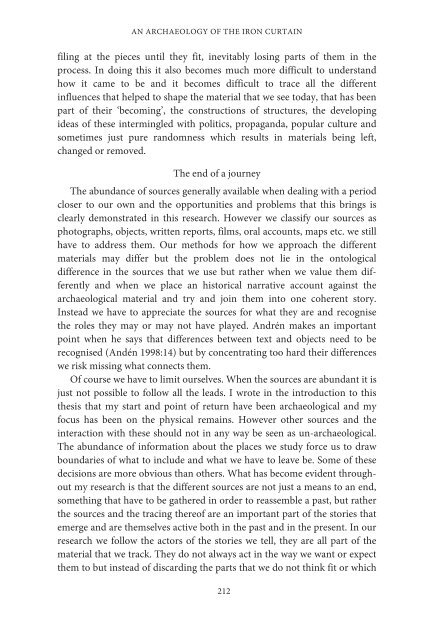1JZGauQ
1JZGauQ
1JZGauQ
Create successful ePaper yourself
Turn your PDF publications into a flip-book with our unique Google optimized e-Paper software.
AN ARCHAEOLOGY OF THE IRON CURTAIN<br />
filing at the pieces until they fit, inevitably losing parts of them in the<br />
process. In doing this it also becomes much more difficult to understand<br />
how it came to be and it becomes difficult to trace all the different<br />
influences that helped to shape the material that we see today, that has been<br />
part of their ‘becoming’, the constructions of structures, the developing<br />
ideas of these intermingled with politics, propaganda, popular culture and<br />
sometimes just pure randomness which results in materials being left,<br />
changed or removed.<br />
The end of a journey<br />
The abundance of sources generally available when dealing with a period<br />
closer to our own and the opportunities and problems that this brings is<br />
clearly demonstrated in this research. However we classify our sources as<br />
photographs, objects, written reports, films, oral accounts, maps etc. we still<br />
have to address them. Our methods for how we approach the different<br />
materials may differ but the problem does not lie in the ontological<br />
difference in the sources that we use but rather when we value them differently<br />
and when we place an historical narrative account against the<br />
archaeological material and try and join them into one coherent story.<br />
Instead we have to appreciate the sources for what they are and recognise<br />
the roles they may or may not have played. Andrén makes an important<br />
point when he says that differences between text and objects need to be<br />
recognised (Andén 1998:14) but by concentrating too hard their differences<br />
we risk missing what connects them.<br />
Of course we have to limit ourselves. When the sources are abundant it is<br />
just not possible to follow all the leads. I wrote in the introduction to this<br />
thesis that my start and point of return have been archaeological and my<br />
focus has been on the physical remains. However other sources and the<br />
interaction with these should not in any way be seen as un-archaeological.<br />
The abundance of information about the places we study force us to draw<br />
boundaries of what to include and what we have to leave be. Some of these<br />
decisions are more obvious than others. What has become evident throughout<br />
my research is that the different sources are not just a means to an end,<br />
something that have to be gathered in order to reassemble a past, but rather<br />
the sources and the tracing thereof are an important part of the stories that<br />
emerge and are themselves active both in the past and in the present. In our<br />
research we follow the actors of the stories we tell, they are all part of the<br />
material that we track. They do not always act in the way we want or expect<br />
them to but instead of discarding the parts that we do not think fit or which<br />
212




